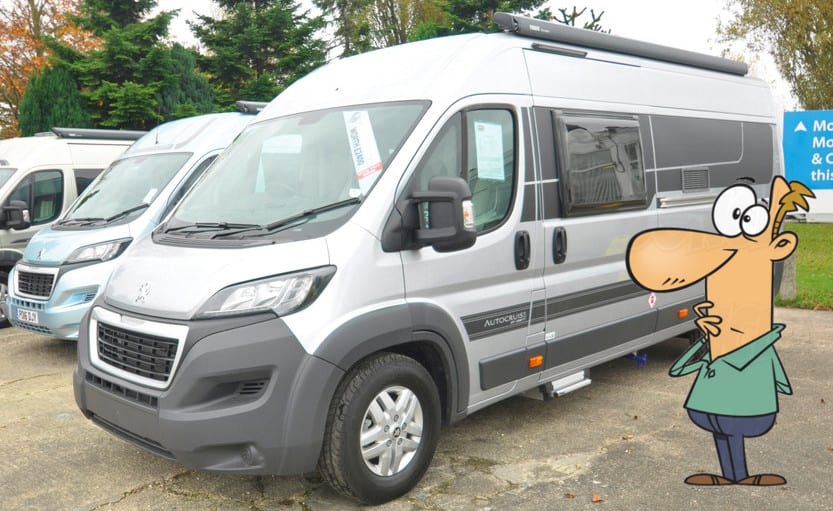
As you can imagine, I get to see a huge range of different motorhomes here at Horton Common. I have guests turn up in older second-hand motorhomes as well as the latest and greatest. Our guests arrive in motorhomes of all different shapes and sizes. However, while most of the motorhomes that arrive are coachbuilt, quite a few of our guests also arrive in panel van conversions. The interesting thing about these conversions is sometimes they are bought as a conversion, and other times the van started out in commercial use and then got modified and kitted out to become a motorhome. So with this post, I wanted to discuss motorhome panel van conversions and their associated benefits (and limitations).

Now, just to clarify, this post on motorhome panel van conversions is by no means a review of the various models available.
I’ll leave all the review stuff of specific motorhome panel van conversions to the clubs and magazines. My intention with this post is to discuss the key concept of a panel van conversion.
If, after reading this, you think the principle of a motorhome panel van conversion can work for you, there are literally hundreds of reviews out there on new and discontinued models.
As always, I hope you have the time to read this post from beginning to end. If not, please feel free to use the Table of Contents below to jump to a particular section.
Disclaimer: Hey! By the way… any links on this page that lead to products on Amazon or Caravan Guard are affiliate links, and I earn a commission if you make a purchase, with no additional cost to you 🙂
- Dissolves waste and removes odours naturally and has delightful mild fragrance
Want To Visit Horton Common? – Book Here
Table of Contents
Introduction To Motorhome Panel Van Conversions
Ok, so to start, I should quickly identify what the difference is between a typical ‘coachbuilt’ motorhome that most of our guests have and a panel van conversion.
Well, when a motorhome manufacturer produces a coachbuilt product, they often start with just a cab and lightweight AL-KO chassis.
Well, a panel van motorhome conversion starts off life a bit differently. Underneath, there will be a more heavy-duty chassis, and the body of the van will be complete.
For a new motorhome panel conversion, a commercial van will be purchased and then modified. However, there are some conversion companies that will accept used vans to work on.
Hence, you source the van, give it to the conversion company, and they carry out the work. In that scenario, the conversion company obviously has no responsibility for anything to do with the cab/engine itself.
There is a couple of different videos on motorhome panel van conversions in this post. The first is a report Practical Motorhome did on panel van conversations from a few years back.
The reason I think this video is worth watching is that it provides a good brief glimpse into the huge range of possibilities panel van conversions can provide.
Not only in layout but in the various shapes, sizes and colours.
So as you can see from the video above, motorhome panel van conversions come in all shapes and sizes.
From tiny little micro-vans to motorhomes with pull-out sides and even brightly coloured offerings in orange or green.
The point is with panel van conversions, if you can think of it, there is a company out there that is probably able to build it for you.
Benefits Of Motorhome Panel Van Conversions
One of the first benefits which I think should be clear is the general size and dimensions of a panel van motorhome.
If you are someone who wants to be more mobile and not just leaving the van on site, you’re going to find life a lot easier with a panel van conversion motorhome.
Take going into town or doing a bit of shopping as an example. Generally, coachbuilt motorhomes are a lot higher and wider.
Therefore, if there are height restrictions on the car park your using which there commonly are, a panel van conversion is easier to live with.
Higher MPG & Hence Lower Fuel Costs
Another benefit of panel van motorhomes is when it comes to fuel efficiency. Yes, pretty much any motorhome engine can be remapped to provide more power/MPG.
However, efficiency and MPG is not just about your engine, it also comes down to aerodynamics and weight.
Typically a coachbuilt motorhome protrudes past the sides of the front cab and quite a bit above the roof. Well, when travelling at speed, those protrusions create air resistance.
That resistance means you need to put your foot down more, using more fuel. With a panel van conversion it generally creates less drag at speed due to the body and sides being flush with the cab, hence a higher MPG.
However, there are a few caveats to my statement above on MPG. First, the chassis of a panel van conversion is generally heavier than the chassis of a coachbuilt motorhome.
One uses a heavy-duty commercial chassis, whereas the other is based on a lightweight AL-KO chassis. So the weight of the respective motorhome is also a significant factor in the resulting MPG.
Secondly, you can have panel van conversions with extras which will increase aero drag and hence reduce MPG. Take permanently mounted awnings, for instance.
How much of an effect they will make on MPG varies etc. In summary, though, you will generally find a motorhome panel van conversion has a higher MPG than many coachbuilt motorhomes.
Bespoke Panel Van Motorhome Conversions
Now, the first video above shows you can have some pretty expensive panel van conversions from new in the £50-60k range.
Well, to save money, some people choose to purchase a used commercial van and then take it to a panel van conversion specialist.
Not only can you potentially save money this way using a second-hand van you also have the choice of going for a bespoke layout. The video below from Practical Motorhome discusses this process.
As John discusses in the video above, part of the advantages of the bespoke approach is you can design the motorhome around how you want to use it.
The example John provides is having a long central section through to the back of the panel van conversion, which is unobstructed.
For going on skiing trips, this is obviously ideal, being able to quickly and easily load the skis through the back doors of the van.
The bespoke approach can also suit the number of passengers you want to take with you. Each passenger will need a proper seat belt restraint.
Some may offer basic lap belts. But really, for the best safety and comfort, each passenger should have a 3-point seatbelt.
Now, you may want more seatbelts than beds. We have had guests in the past, where the whole family travels in a motorhome, but it is only designed with one bed.
Typically the parents sleep in the motorhome, and the kids stay in a tent outside or the other way around.
That way, even a modest panel van conversion can have the full facilities of a kitchen, toilet and shower which the whole family can use.
Bespoke Motorhomes For Disabled Users
For many people, the bespoke nature of panel van conversions suits their particular family circumstances or leisure activities.
However, for some disabled people, what a bespoke motorhome panel van conversion offers is freedom, as is the case with the conversion seen in the video below.
As is shown in the video above, a panel van conversion motorhome could have an automated door along with a motorised lift and swivel cab chair.
This enabled that particular wheelchair-bound individual to have the freedom to get themselves around without assistance.
This is just one example and set of circumstances, many others exist that bespoke panel van conversions can cater for.
Drawbacks Of Motorhome Panel Van Conversions
Really, the biggest drawback is around available space.
You can get vans with a longer wheelbase, but in general, you’re not going to have interiors as large as many of the coachbuilt motorhomes built on using the same cab.
If you’re above average height, that may also be a bit of a problem with a panel van conversion. Yes, there are conversion companies which can cut out the existing roof and place a ‘high-top’ up there.
But in doing so, it is adding additional cost, so the total cost starts to creep closer to that of a coachbuilt motorhome.
Furthermore, if you go for a high-top option, you won’t be able to take the panel van motorhome into as many carparks, which is one of their key benefits of the lower profile vans.
Conclusions On Motorhome Panel Van Conversions
Many of our guests who own panel van conversions cover some serious miles each year. Going from the upper reaches of Scotland down to the southern parts of Europe.
They have told me a panel van conversion just gives them that extra bit of flexibility to go to places which would be more difficult to navigate with a larger coachbuilt motorhome.
I do also like talking to our guests who have gone through the challenge of building their own panel van conversion.
I’ve previously written a post on motorhome leisure battery placement and how important it is, but really that’s just one small puzzle in the whole DIY build.
Another one is choosing suitable upholstery foam. If you are going to purchase a motorhome/commercial van via private sale, you need to be vigilant of potential fraudsters.
Anyway, if you are looking to purchase a motorhome, I hope this post has given you some ‘food for thought’ on if a panel van conversion would be right for you.
If not, you may want to read my post on motorhome classes.
If you’re potentially interested in a coachbuilt motorhome, I also have a post on how a motorhome is built.
Finally, I hope once you are set up with your motorhome, you will consider coming to visit us here at Horton Common in the near future. 🙂
Want To Visit Horton Common? – Book Here

